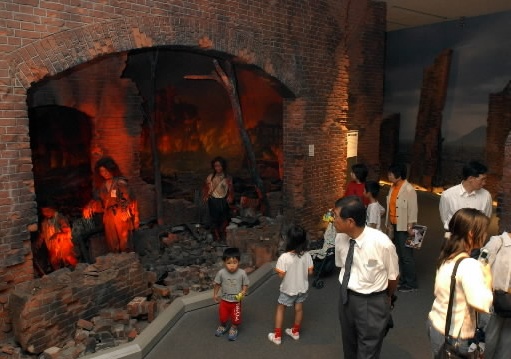Conveying the A-bomb Experience, Part 6
Jul. 5, 2010
Learning about the A-bomb experience
by Kunihiko Sakurai, Masaki Kadowaki, and Takahiro Yamase, Staff Writers
The heat of the atomic fire, the agony of burned bodies, the grief wrought by families torn apart, the rage felt toward war… What should be done to etch the experiences borne of that day in our minds and in our memories, for generations to come, as the A-bomb survivors (hibakusha) and the family members of the A-bomb victims age? In this series (originally published in July and August 2004), the Chugoku Shimbun will consider the significance and challenges of conveying the A-bomb experience, with a focus on new efforts taking place in the A-bombed city of Hiroshima.
Three victims of the atomic bombing wander among the rubble of the city, their skin, burned severely in the blast, hanging from their bodies in strips.
These victims, depicted in the form of wax figures, stand at the entrance to the west wing of Hiroshima Peace Memorial Museum. The museum conveys the unprecedented disaster of the atomic bombing through such means as the belongings of A-bomb victims.
On the afternoon of July 22, in front of the three red-lit figures, a first-grade boy from Yoshijima Higashi Elementary School in downtown Hiroshima, looked away and hid behind his mother. Motivated by a peace education class in school, he was visiting the museum for the first time during the summer vacation. Describing his impressions of the museum, he used the word "scary."
The route through the museum begins in the east wing, which employs a chronological approach in introducing the history behind the atomic bombings, the process of Hiroshima's reconstruction, and the current nuclear age. The west wing follows, which focuses on the scars of the bombing, including the victims' belongings and the aftereffects of radiation. As it takes about three hours to make a thorough tour of the museum, students on school trips tend to end up moving quickly through the museum to accommodate tight schedules.
A questionnaire conducted by the museum since last year in advance of the 50th anniversary of the museum's opening next year has revealed that visitors and experts have voiced the view that "If the museum makes its appeal based solely on outward appearances of the atomic bombing, visitors may feel that it's not the bomb that's scary, but the museum itself." This view calls for opening a new route through the museum which takes into consideration the age of visitors.
Kazuhiko Takano, 48, deputy director of the museum, shared the dilemma: "The inhumanity of the atomic bombing and the importance of peace and life... How can we strike a balance between them in the exhibition?" In light of such opinions from the public, the museum intends to decide on a plan, by next summer, to renovate the exhibition.
How do younger generations perceive the reality of the atomic bombing? Satoru Ubuki, 57, a professor at Hiroshima Jogakuin University and a specialist in Japanese history, pulled an envelope off a shelf in his office. It contains essays entitled "My Hiroshima," which Professor Ubuki had assigned to 110 students last fall.
The essays say such things as "I visited Hiroshima Peace Memorial Museum when I was an elementary school student" and "I've heard about the bombing from my grandparents." Ninety percent of the students are from the city of Hiroshima or its environs, but there are few descriptions of the atomic bombing. The students argue against war in their papers, shifting the subject to the Iraq War and the peril of terrorism. Professor Ubuki thinks, "They feel as if they 'have already addressed the issue' through peace education programs in their childhood or they have an adverse reaction to this issue due to a heavy involvement in peace education programs." Adding that "They seem fed up with the atomic bombing and peace issues," Professor Ubuku is concerned that young people may "distance themselves from Hiroshima issues."
This spring the Hiroshima Municipal Board of Education prepared instructional materials for peace education programs and distributed them to 137 elementary schools. Behind this effort is the fact that only slightly more than 30 percent of students were able to provide the correct answer concerning the date and time of the atomic bombing in a survey conducted two years ago that targeted about 1,500 elementary school students from the fourth to the sixth grade.
The instructional materials include a plan which provides comprehensive guidance. This plan has been implemented in the classroom by veteran teachers, who served as chief editors of the project. With the aim of enabling children to learn about the history behind the atomic bombings and the reality of the damage that was produced, the instructional materials detail a range of things, including how many hours should be used for peace education classes, which teaching materials should be used for quotations, what and how teachers should write on the blackboard, and a guide to visiting A-bomb-related monuments.
Before long, all classrooms will be in the hands of teachers who were born after the war. Commenting on this situation, the Hiroshima Municipal Board of Education said, "First of all, teachers must return to the basic facts of the atomic bombing in order to hand down the A-bomb experience without fail." The board has, for the first time, included funds in this fiscal year's budget so that A-bomb survivors can be invited to visit all the elementary schools in the city and children will have the opportunity to hear their accounts of the atomic bombing.
(Originally published on July 27, 2004)








